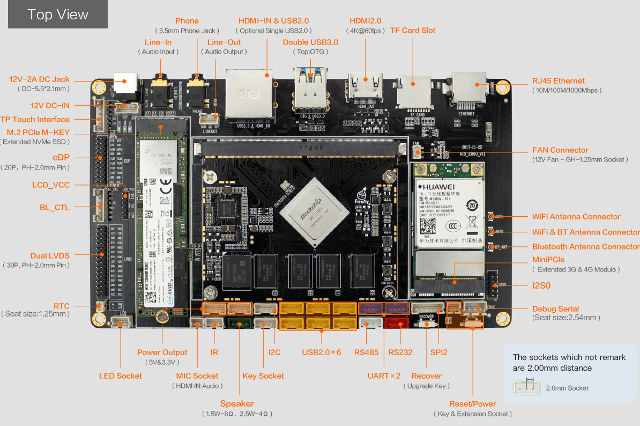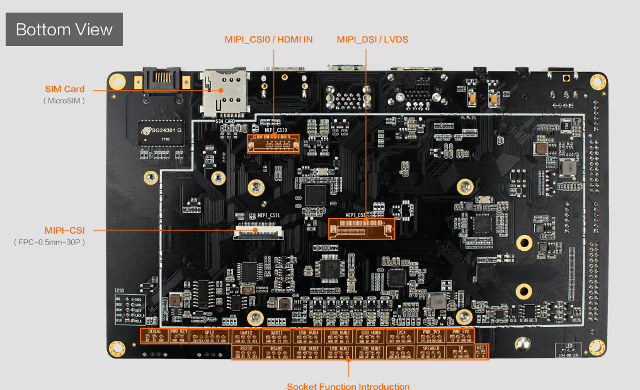Firefly-RK3399 was the very first Rockchip RK3399 development board when it launched in late 2016, and it mostly stayed that way until others joined in late 2017, early 2018 with products like Orange Pi RK3399, ODROID-N1, Rock960, or Pine64 RockPro64 among others.
Firefly team has now unveiled another higher end “all-in-board industrial board” with their Firefly AIO-3399J board featuring their RK3399 CoreBoard module, and a baseboard exposing plenty of I/O and connector, including support for M.2 drives, and 4G LTE mini PCIe cards.

Firefly AIO-3399J specifications:
- SoM – RK3399 CoreBoard:
- SoC – Rockchip RK3399 hexa-core big.LITTLE processor with dual core ARM Cortex A72 up to 2.0 GHz and quad core Cortex A53 processor, ARM Mali-T860 MP4 GPU with OpenGL 1.1 to 3.1 support, OpenVG1.1, OpenCL and DX 11 support
- System Memory – 2GB or 4GB DDR3-1333
- Storage – 16GB eMMC 5.1 flash (other capacities also available on demand up to 128GB)
- RK808 PMU
- 8-layer PCB
- Baseboard:
- Storage – M.2 M-Key slot working with NVMe SSD, micro SD card slot
- Video & Display Interfaces
- 1x HDMI 2.0 output up to 4K @ 60 Hz with HDCP 1.4/2.2
- Optional 1x HDMI input up to 1080p60
- 1x eDP 1.3 (4-lanes @ 10.8 Gbps)
- Dual channel MIPI DSI interface up to 2560×1600 @ 60 Hz
- Dual channel 24-bit LVDS up to 1920×1200 @ 60 Hz
- Video Decode – 4K VP9 and 10-bit H.265 video codec support up to 60 fps
- Audio
- HDMI audio output
- MIC audio input
- Analog audio via 3.5mm combo jack with stereo for output and input
- S/PDIF output interface
- 1x LINE in via 3.5mm jack, 1x LINE out via header
- Dual speaker support (8Ω/1.6W or 4Ω/2.7W)
- I2S output and input interface up to 8 channels
- Connectivity
- Gigabit Ethernet port using RTL8211E transceiver
- WiFi 802.11ac 2×2 MIMO and Bluetooth 4.1
- Optional 3G/4G LTE mini PCIe module
- USB – 1x USB 2.0 host port, 2x USB 3.0 port, 6x USB 2.0 headers
- Camera
- 2x MIPI CSI interfaces up to 13MP or 2x 8MP
- 1x DVP camera interface up to 5MP
- Serial – 1x RS232, 2x TTL serial, 1x RS485
- Debugging – 3-pin serial header
- Expansion
- 1x mini PCIe for 3G/ 4G LTE card
- 1x M.2 M-key
- 1x SIM card slot
- Headers exposing SPI, I2C, ADC, GPIO, keys, power inputs and outputs
- Misc – IR receiver, RTC with battery socket, reset & recovery keys,
- Power Supply – 12V/2A DC
- Dimensions – 182.8 x 107.1 mm (4-layer PCB)

The board supports Android 7.1, Android 6.0,Ubuntu 16.04, and u-boot, and comes with an “open source SDK and related materials”, all of which you can find via the product page.
Firefly AIO-3399J board can be purchased now for $165 with 2G RAM/16GB flash or $235 with 4GB RAM/16GB flash directly on Firefly Shop. Note the boards currently sold do not come with HDMI input.

Jean-Luc started CNX Software in 2010 as a part-time endeavor, before quitting his job as a software engineering manager, and starting to write daily news, and reviews full time later in 2011.
Support CNX Software! Donate via cryptocurrencies, become a Patron on Patreon, or purchase goods on Amazon or Aliexpress





Hmm, $70 price difference for 2GB RAM?
They learnt this from nvidia 😉
Actually, no, this is likely to be costs.
Maybe a tad much, but RAM is really quite expensive right now.
Price the retail delta there. It’s close to that.
So RockPro64 with 2 GB for $65 or 4GB at $79 is what exactly? https://www.cnx-software.com/2018/01/29/pine64-to-release-rockpro64-boards-based-on-rockchip-rk3399-and-rk3399pro-for-60-and-up/
BTW: Above it could be read DDR3-1333 — a bit strange when this device is equipped with tons of camera and video interfaces. I always thought you need memory bandwidth then?
Has the market changed that much last month? DDR4 retail prices were at 10eur-$12/GB level 2 months ago for 8Gb devices. In this case we are talking of $30+/GB, for DDR3.
For the SoM the difference between 2GB and 4GB is $24: http://shop.t-firefly.com/goods.php?id=58
That’s exactly what I’d expect – $12/GB. So perhaps there is something more in the carrier package than just 2GB more at $35/GB.
This is an interesting device. What would maybe open up some “doors” would be having the board be in ITX format.
The 4GB board being over $150 also puts this over Celeron + board + RAM, so desktop/server uses are out for me.
The 4GB device is priced almost the same as a latest HP Microserver Gen10, which brings 8GB DDR4 and a power supply.
What are the actual use cases people buy this for?
Product development most likely. Although this claims to be an industrial board, although I see nothing in the specs that makes it that…
Considering that there’s no temp range given in the specs, I can’t see how you could claim it either way right now. You need to review the parts one by one in the BOM before making that remark, to be honest.
Maybe look again at ‘Video & Display Interfaces’ and Camera?
That was kind of my point. What can’t you do with an ITX motherboard that you can with this? Only the interfaces would be different.
TLS mentions product development, so that kind of makes more sense to me. I mostly only deal with one or two SBCs and desktop/server systems, so this world is unknown to me.
The rk3399 is getting quite old now, surely a new version with a73 or a75 cpu core is overdue?
Tell that to TI, they still sell Cortex-A8 single core SoCs,
The SoC is definitely not old — it got sampled in 2016 and found wide adoption only last year. If you’re thinking of A72 — that’s normal for Arm Holdings — they announce their designs much earlier than those find wide adoption in SoCs, premium-phone derivatives non-withstanding. That’s a drawback of the stock IP vendor –> SoC vendors model — things have to ‘trickle down’.
I agree with Blu. Even Intel SoCs are moving at a very slow pace from “announced” to designs on the market. Apollo Lake was a slow as molasses ramp and Gemini Lake is looking like it will be the same. Lots of OEMs still selling most Braswell designs to this day.
To much pie and not enough eaters.
The markets sales hold the answers